
The cubit is an ancient unit of length based on the distance from the elbow to the middle finger. It's primarily associated with the Sumerians, Egyptians and Israelites. "Cubits" is found in the Bible re: Noah's Ark, Ark of the Covenant, Tabernacle, Solomon's Temple. The common cubit was divided into 6 palms × 4 fingers = 24 digits. Royal cubits added a palm for 7 palms × 4 fingers = 28 digits. These lengths typically ranged between 444 and 529.2 mm, with an ancient Roman cubit being as long as 120 cm (47 in).

Quercus suber, commonly called the cork oak, is a medium-sized, evergreen oak tree in the section Quercus sect. Cerris. It is the primary source of cork for wine bottle stoppers and other uses, such as cork flooring and as the cores of cricket balls. It is native to southwest Europe and northwest Africa. In the Mediterranean basin the tree is an ancient species with fossil remnants dating back to the Tertiary period.

Poa pratensis, commonly known as Kentucky bluegrass, smooth meadow-grass, or common meadow-grass, is a perennial species of grass native to practically all of Europe, North Asia and the mountains of Algeria and Morocco. Although the species is spread over all of the cool, humid parts of the United States, it is not native to North America. The Spanish Empire brought the seeds of Kentucky bluegrass to the New World in mixtures with other grasses. Poa pratensis forms a valuable pasture plant, characteristic of well-drained, fertile soil. It is also used for making lawns in parks and gardens and is common in cool moist climates like the Pacific Northwest, and Northeastern United States. When found on native grasslands in Canada, however, it is considered an unwelcome exotic plant, and is indicative of a disturbed and degraded landscape.

Soursop is the fruit of Annona muricata, a broadleaf, flowering, evergreen tree. The exact origin is unknown; it is native to the tropical regions of the Americas and the Caribbean and is widely propagated. It is in the same genus, Annona, as cherimoya and is in the Annonaceae family.
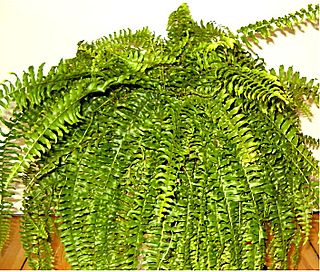
Nephrolepis exaltata, known as the sword fern or Boston fern, is a species of fern in the family Lomariopsidaceae native to tropical regions throughout the world. This evergreen plant can reach as high as 40–90 centimetres (16–35 in), and in extreme cases up to 1.5 metres. It is also known as the Boston swordfern, wild Boston fern, Boston Blue Bell Fern, tuber ladder fern, or fishbone fern.

Asphodelus albus, common name white asphodel, is a herbaceous perennial plant belonging to the genus Asphodelus.

Quercus acutissima, the sawtooth oak, is an Asian species of oak native to China, Tibet, Korea, Japan, Indochina and the Himalayas. It is widely planted in many lands and has become naturalized in parts of North America.

Berberis vulgaris, also known as common barberry, European barberry or simply barberry, is a shrub in the genus Berberis. It produces edible but sharply acidic berries, which people in many countries eat as a tart and refreshing fruit.
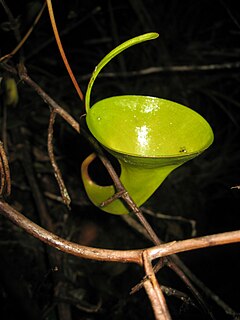
Nepenthes inermis is a tropical pitcher plant endemic to Sumatra. The specific epithet inermis is Latin for "unarmed" and refers to the upper pitchers of this species, which are unique in that they completely lack a peristome.
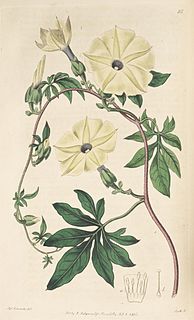
Ipomoea tuberculata is a flowering plant species in the bindweed family (Convolvulaceae). It belongs to the morning glory genus, Ipomoea.

Ramonda myconi, the Pyrenean-violet or rosette mullein, syn. R. pyrenaica, is a species of flowering plant in the family Gesneriaceae, which is a relictual endemite of shady, rocky places in the Pyrenees and north eastern Spain. It is a rosette-forming evergreen perennial growing to 10 cm (4 in) high by 20 cm (8 in) broad, with oval, crinkled leaves. Five-petalled purple flowers with prominent yellow anthers appear on leafless stems in spring.

Sinapis arvensis, the charlock mustard, field mustard, wild mustard or charlock, is an annual or winter annual plant of the genus Sinapis in the family Brassicaceae. It is found in the fields of North Africa, Asia and Europe. Pieris rapae, the small white butterfly, and Pieris napi, the green veined white butterfly are significant consumers of charlock during their larval stages.
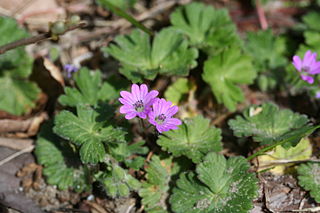
Geranium molle, the Dove's-foot Crane's-bill or Dovesfoot Geranium, is an annual herbaceous plant of the family Geraniaceae.
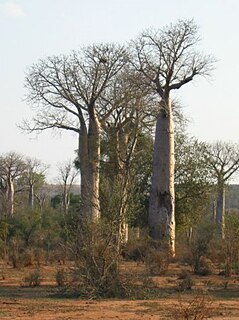
Adansonia za is a species of baobab in the genus Adansonia of the family Malvaceae. It was originally named in French as anadzahé. Common names in Malagasy include bojy, boringy, bozy, bozybe, ringy, and za, the last of which gives the plant its specific epithet. Eight Adansonia species are recognized, with six endemic to Madagascar. Adansonia za is the most widespread of the Madagascar endemics.

Coleostephus is a genus of flowering plants in the family Asteraceae.

Hippocrepis emerus, the scorpion senna, is a species of perennial plant belonging to the genus Hippocrepis in the family Fabaceae.

Hakea macraeana, commonly known as the willow needlewood or Macrae's hakea, is a species of shrub native to eastern Australia. The species was first formally described by botanist Ferdinand von Mueller in 1886 in the Australian Journal of Pharmacy. The species name honours one George Macrae, who aided the original collector William Baeuerlen.

Stachys recta, commonly known as stiff hedgenettle or perennial yellow-woundwort, is herbaceous perennial plant of the family Lamiaceae.

Hakea francisiana, commonly called the emu tree, grass-leaf hakea or bottlebrush hakea, is a shrub or tree of the genus Hakea native to Western Australia and South Australia.

Hakea nitida, commonly called the frog hakea or shining hakea, is a shrub of the family Proteaceae and is endemic to an area in the southern Wheatbelt, Great Southern and Goldfields-Esperance regions of Western Australia.




















